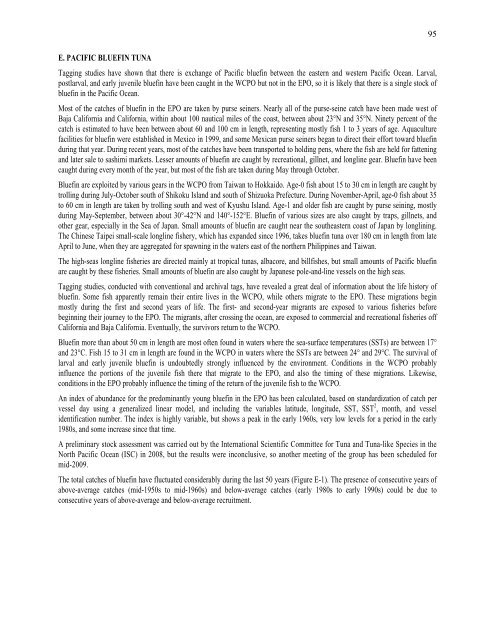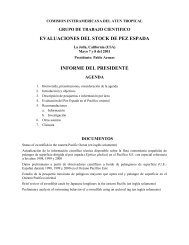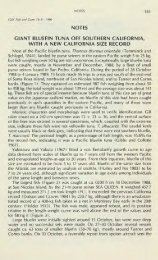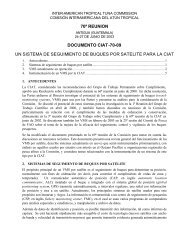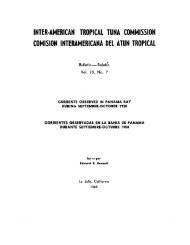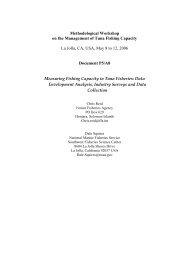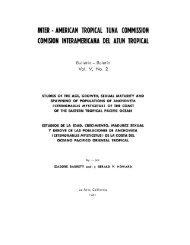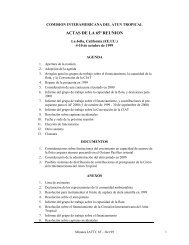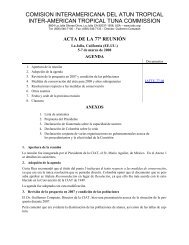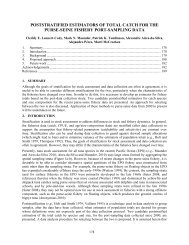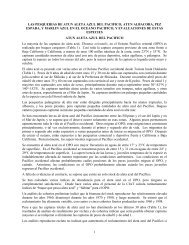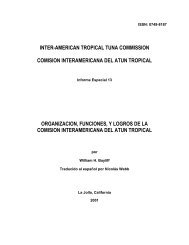INTER-AMERICAN TROPICAL TUNA COMMISSION - Comisión ...
INTER-AMERICAN TROPICAL TUNA COMMISSION - Comisión ...
INTER-AMERICAN TROPICAL TUNA COMMISSION - Comisión ...
- No tags were found...
Create successful ePaper yourself
Turn your PDF publications into a flip-book with our unique Google optimized e-Paper software.
E. PACIFIC BLUEFIN <strong>TUNA</strong>Tagging studies have shown that there is exchange of Pacific bluefin between the eastern and western Pacific Ocean. Larval,postlarval, and early juvenile bluefin have been caught in the WCPO but not in the EPO, so it is likely that there is a single stock ofbluefin in the Pacific Ocean.Most of the catches of bluefin in the EPO are taken by purse seiners. Nearly all of the purse-seine catch have been made west ofBaja California and California, within about 100 nautical miles of the coast, between about 23°N and 35°N. Ninety percent of thecatch is estimated to have been between about 60 and 100 cm in length, representing mostly fish 1 to 3 years of age. Aquaculturefacilities for bluefin were established in Mexico in 1999, and some Mexican purse seiners began to direct their effort toward bluefinduring that year. During recent years, most of the catches have been transported to holding pens, where the fish are held for fatteningand later sale to sashimi markets. Lesser amounts of bluefin are caught by recreational, gillnet, and longline gear. Bluefin have beencaught during every month of the year, but most of the fish are taken during May through October.Bluefin are exploited by various gears in the WCPO from Taiwan to Hokkaido. Age-0 fish about 15 to 30 cm in length are caught bytrolling during July-October south of Shikoku Island and south of Shizuoka Prefecture. During November-April, age-0 fish about 35to 60 cm in length are taken by trolling south and west of Kyushu Island. Age-1 and older fish are caught by purse seining, mostlyduring May-September, between about 30°-42°N and 140°-152°E. Bluefin of various sizes are also caught by traps, gillnets, andother gear, especially in the Sea of Japan. Small amounts of bluefin are caught near the southeastern coast of Japan by longlining.The Chinese Taipei small-scale longline fishery, which has expanded since 1996, takes bluefin tuna over 180 cm in length from lateApril to June, when they are aggregated for spawning in the waters east of the northern Philippines and Taiwan.The high-seas longline fisheries are directed mainly at tropical tunas, albacore, and billfishes, but small amounts of Pacific bluefinare caught by these fisheries. Small amounts of bluefin are also caught by Japanese pole-and-line vessels on the high seas.Tagging studies, conducted with conventional and archival tags, have revealed a great deal of information about the life history ofbluefin. Some fish apparently remain their entire lives in the WCPO, while others migrate to the EPO. These migrations beginmostly during the first and second years of life. The first- and second-year migrants are exposed to various fisheries beforebeginning their journey to the EPO. The migrants, after crossing the ocean, are exposed to commercial and recreational fisheries offCalifornia and Baja California. Eventually, the survivors return to the WCPO.Bluefin more than about 50 cm in length are most often found in waters where the sea-surface temperatures (SSTs) are between 17°and 23°C. Fish 15 to 31 cm in length are found in the WCPO in waters where the SSTs are between 24° and 29°C. The survival oflarval and early juvenile bluefin is undoubtedly strongly influenced by the environment. Conditions in the WCPO probablyinfluence the portions of the juvenile fish there that migrate to the EPO, and also the timing of these migrations. Likewise,conditions in the EPO probably influence the timing of the return of the juvenile fish to the WCPO.An index of abundance for the predominantly young bluefin in the EPO has been calculated, based on standardization of catch pervessel day using a generalized linear model, and including the variables latitude, longitude, SST, SST 2 , month, and vesselidentification number. The index is highly variable, but shows a peak in the early 1960s, very low levels for a period in the early1980s, and some increase since that time.A preliminary stock assessment was carried out by the International Scientific Committee for Tuna and Tuna-like Species in theNorth Pacific Ocean (ISC) in 2008, but the results were inconclusive, so another meeting of the group has been scheduled formid-2009.The total catches of bluefin have fluctuated considerably during the last 50 years (Figure E-1). The presence of consecutive years ofabove-average catches (mid-1950s to mid-1960s) and below-average catches (early 1980s to early 1990s) could be due toconsecutive years of above-average and below-average recruitment.95


